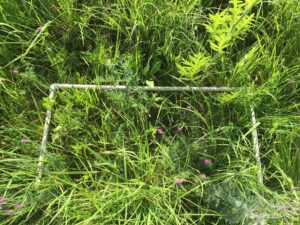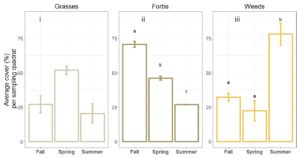Final report for GNC18-257
Project Information
Farmers are tasked with increasing commodity production and mitigating the environmental damage associated with this production in the coming century. Traditionally, agricultural production land and conservation land are managed on different acres, but the STRIPS (Scientific Trials of Row-crops Integrated with Prairie Strips) project at Iowa State University is a collaboration between researchers and farmers to increase native habitat on working agricultural lands. Strategically integrating native, perennial vegetation can serve many needs by taking land out of production that is already low yielding, reducing soil and nutrient export through the integration of continuous, deep-rooted cover, and providing suitable habitat for pollinators, beneficial insects, and wildlife. Native, perennial plantings may better confer the aforementioned ecosystem services if they are more diverse. This project aims to assess reconstructed prairie communities through vegetation surveys on 21 farms that adopted STRIPS in 2012- 2016. Farmer collaborators will gain an increased knowledge of prairie plant identification through in-person tutorials and customized reports detailing the number and abundance of native species in their crop fields. Farmer-to-farmer knowledge sharing will be enhanced through a field day, and results will be shared with the greater sustainable agricultural community through a poster presentation and a peer-reviewed journal article. The extent to which farmers increased their knowledge of prairie plant identification will be evaluated with a follow-up survey. This project will provide foundational data to farmers and landowners, as well as inform future partners and collaborators of the ways in which certain factors, like management practices or habitat size, may impact the species diversity of prairie strips. This project will help bring together farmers and conservation biologists in reconciling the tension that often exists between large-scale agriculture and habitat diversity and will help sustain the natural resources upon which agriculture depends.
Learning outcomes:
Farmers and landowners will learn native prairie species identification. I will facilitate this learning by a) walking their strips with them during my farm visits, b) sending them an update about the species I identify after my first year of sampling, and c) sending them an individualized report after my second year of sampling with a more complete description of species found. By compiling data from many farms, I also anticipate my research will assist past and future practitioners increase native species diversity through various management tools.
Action outcomes:
Farmers will use this increased knowledge of native plant identification in farmer-to-farmer knowledge sharing. Every year there are field days at farms with prairie strips, hosted by Iowa State University or other organizations (e.g., Practical Farmers of Iowa). While Iowa State University can reach out to the general population to increase STRIPS adoption, STRIPS has already become a successful, ubiquitous practice because of farmer-to-farmer communication. Showing farmers the diverse native species that are populating their STRIPs (as outlined in learning outcomes) will help increase the adoption of the prairies strips. STRIPS' barriers to implementation are not only that it takes land out of production, but also that it puts non-crop "weedy" vegetation in the middle of the crop field. Helping farmers be able to sort out the weeds from the native prairie plants and share that knowledge with others will aid in even greater understanding and implementation, which will further conserve soil and benefit natural resource management.
Research
In order to assess patterns of plant biodiversity and community composition in on-farm restorations we visited 21 sites in the summer of 2018 and 26 sites in the summer of 2019 to survey the vegetation in their already established prairie strips. All sites had seeded the prairie strips into their agricultural fields between 2012 and 2016. We conducted our surveys between mid July and mid-August when the prairie was in peak flowering. At each site 24 quadrats, or vegetation sampling points, were taken. Sites differed in the size, number, and configuration of the prairie strips so sampling point locations were randomly chosen through ArcGis, uploaded to a Trimble GeoXT GPS unit, and staked in the field. All sampling points were at least 5m from each other and 2m from the edge of the prairie strip. If sites had more than one prairie strip then the number of sampling points was proportional to the strip's area. Each strip had at least one sampling point. We visited approximately the same sampling point locations between 2018 and 2019.
The sampling quadrat is a rectangle measuring 0.5m x 1m (Figure 1). Within each quadrat the identity and the visual percent cover of each species was determined. Percent cover estimates are binned into 7 cover "classes" (<1%, 1-5%, 5-25%, 25-50%, 50-75%, 75-95%, >95%). Because the vegetation has multiple canopy layers, total cover estimates in a quadrat often exceed 100%.

We sub-classified species according to their life history attributes. Species were denoted as "prairie species" if they were listed in the University of Iowa Librarie's "Iowa Prairie Plants" database. Some species were not listed on this website but were included in a seed mix and those species were also classified as "prairie." All other non-woody species were classified as "weedy" whether they were native or exotic. We believe this classification most accurately describes the desired and undesired plants in these conservation plantings.
We converted our cover classes to midpoint values for our analysis of the survey data. We used the Shannon diversity Hill number as our measured of diversity. We focused our analysis on the effect of the seed mix on the diversity and community composition of the prairie strips, as the seed mix is the biggest economic investment a farmer/landowner makes in their restoration. We also assessed whether factors such as a site's age, its size, and the season in which it was planted (fall/winter, spring, or summer) affected the diversity or community composition of a site.
We found that the diversity of the seed mix was positively associated with the diversity of a site and the species richness of the prairie community. We also found that larger sites tended towards being more diverse on average. We did not find, however, that the diversity of the seed mix was associated with greater cover by prairie species and less cover by weedy species. We had six sites that we visited in the summer of 2019 that seeded the same seed mix, which allowed us for us to control for some variation. When we examined these six sites alone we found that the diversity did not vary between them, however the season a site was planted influenced the cover of prairie forbs and weedy species. Sites that were seeded in the fall had a higher coverage of forbs on average while sites that were seeded in the summer had a coverage of weeds on average (Figure 1).

Our work sheds light on some of the patterns that emerge across in-field restorations that differ in a myriad of ways and are managed by independent landowners. We found that seeding a diverse mix can result in a diverse stand of vegetation, but that including more species in the seed mix alone does not result in a lower abundance of weedy species. When we control for the seed mix we find that the season in which a site is planted does matter in terms of shaping the abundance of different functional groups. Future work should continue to examine the most practical and effective seed mixes for these on-farm restorations.
Educational & Outreach Activities
Participation Summary:
We wrote three informal publications aimed at sharing the results of our research and/or increasing general knowledge of plant identification.
- "Vegetation surveys across prairie strips of Iowa" details the results of our surveys from 2018 and gives a general background on prairie strips. This handout was distributed at the Practical Farmers of Iowa field day.
- "Get to know your grasses" includes photos and identification information for 8 common prairie grasses. We find that grasses are often the hardest group of plants to identify. This handout gives helpful tips as well as glossary of terms useful in botanical identification.
- Individualized reports with the results of the 2018 and 2019 vegetation surveys for each farm. These reports were custom made for each cooperating farmer/landowner (n = 26). Each report gives an overview of the sampling methodology, the number of species found, the cover of different functional groups, and photos of all the prairie species. We hope these reports can serve as a customized guide for identifying plants on each farm.
I gave a talk entitled "In-field prairie plants as a means to increase native plant diversity in an agricultural landscape" at the North American Prairie Conference (NAPC) in June 2019 (Houston, Texas). This talk was well attended (50+). The audience included many conservation practitioners as well as farmers from the surrounding area.
I talked at the Practical Farmers of Iowa field day "Prairie and Beneficial Insect Habitat on an Organic Crop Farm" in July of 2019. 46 people attended the field day.
I recapped my research for the Iowa State community during my exit seminar on June 3, 2020. My seminar was called "Improving the Outcomes of Prairie Restorations within Croplands". I invited all of my farmer cooperators and roughly 40 people attended.
I gave a talk at the 2020 virtual Ecological Society of America conference, August 3-6 called "Understanding Differences in community composition of in-field prairie plantings in Iowa, USA." A recording of the talk can be found here.
We are in the process of submitting my research for publication in a peer-reviewed journal and will update this report once the results are published.
Project Outcomes
This project has increased farmer cooperation and enthusiasm for on-farm prairie restorations. Over 80% of the farmer cooperators surveyed stated that their plant identification skills increased over the course of my two-year project. And 75% indicated they were further interested in learning more about plant dynamics in their prairie strips at the end of my project period.
My research will contribute to the general understanding of how the practice of planting in-field prairie restorations can be successful across varying operations and my one-on-one interactions have helped farmer cooperators become more aware of the dynamics occurring on their own farm. I think this project has highlighted for farmers the social benefits that having prairie strips afford. See quotes below (in "success stories") for some specific examples.
Throughout this project, I was lucky enough to traverse across the state of Iowa and visit farms that differ in size, management practices, and surroundings. However, at each of these varying farming operations the owners and operators are integrating natural habitat for a variety of goals. I was excited about interacting with all the farmers I visited and I was continually impressed when talking with them. I'm looking forward to continuing to work with them in the future
I received a number of positive comments from my farmer cooperators during my wrap up evaluation, which I sent out in the fall of 2019. Here a few examples:
"I really enjoyed walking with Lydia through the pollinator habitat and having her identify the prairie plants. The survey results folder you sent is fantastic with such great color pictures. I want to plant more area to pollinator habitat prairie strips."
"Having you ID my prairie strips adds to my enjoyment of having the prairie seeding on my farm!"
"I have found this to be very helpful to be clued in to what is happening in the prairie strips & encourage full identification of my plants in the future. P.S. we roughly calculated we have ~10 barn swallows so in a 4 month period they consume ~ 420,00 insects in a season!"
"Thanks for your work. I passed the study along to my friends who are not so plant-challenged as me. And they are enjoying the brochure."
Information Products
- Get to know your grasses (Manual/Guide)
- Vegetation surveys across prairie strips of Iowa (Fact Sheet)